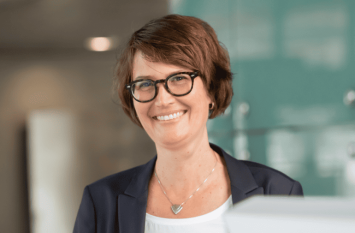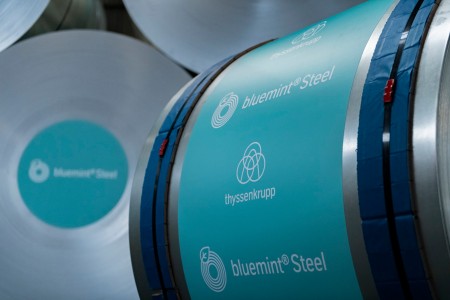Daily press, 2024-02-20, 09:30 am
Climate protection to the power of two: thyssenkrupp Electrical Steel provides Siemens Energy with bluemint® powercore® to reduce CO2 footprint of transformers in offshore wind farms
- thyssenkrupp Electrical Steel receives order from Siemens Energy for CO2-reduced electrical steel bluemint® powercore®
- Around 700 transformers made of the lower CO2 emission material are installed in the nacelles of offshore wind turbines for Siemens Energy’s wind power business Siemens Gamesa
- More than 12,000 tons of CO2 avoided
- Delivery of bluemint® powercore® will take place over three years until the end of 2026
- Project is part of a collaboration between thyssenkrupp Electrical Steel and Siemens Energy for the decarbonization of the energy industry
thyssenkrupp Electrical Steel has received the largest ever order from Siemens Energy for bluemint® powercore® to equip around 700 transformers in offshore wind turbines from its wind business Siemens Gamesa, – a record order for thyssenkrupp Electrical Steel. The two frontrunners in decarbonization intend to lead the decarbonization of the electricity industry and as well to secure capacity of CO2-reduced steel, enabling a resilient and sustainable supply chain for the energy transition.
bluemint® Steel – certified CO2 saving
bluemint® powercore® realizes the CO2 reduction by using a specially processed scrap recycling product in the blast furnace at the thyssenkrupp Steel site in Duisburg. This technological change will result in an absolute reduction of CO2 emissions at the Duisburg site, because less coal is needed for the reduction process in the blast furnace. Using a mass balance approach, only the scrap-based production route in the blast furnace is considered. TÜV Süd confirmed this approach in accordance with the VERIsteel procedure and certified bluemint® Steel as a product with a reduced CO2 intensity. With this approach, thyssenkrupp Steel can already offer CO2-reduced products today. However, the aim is to make the entire production process climate-neutral with the tkH2Steel transformation project. To this end, thyssenkrupp Steel is building a direct reduction plant at the Duisburg site, which will also save CO2 emissions on a global scale from 2027 by using hydrogen and renewable electricity.
CO2-reduced transformers for the decarbonization of the energy industry
The project is a double benefit for climate protection in Europe: In the future, even more green electricity will be generated in offshore wind turbines, while at the same time the CO2 footprint of manufacturing transformers in the wind turbines will be reduced through the use of the highly efficient grain-oriented electrical steel bluemint® powercore®.
The cores of transformers in offshore wind turbines are made of grain-oriented electrical steel. This special steel enables transformers to operate with a high level of efficiency, transforming electric energy with as little loss as possible. The lower the iron losses of the electrical steel, the higher the efficiency. This is key when it comes to meeting increasing demand for electricity and the need to generate more power from renewable sources. They ensure that the green electricity is efficiently converted from low to medium voltage and fed into the local power grids via high-voltage lines or underground cables with low losses. Siemens Energy will manufacture the 700 transformers made of bluemint® powercore® at its Weiz plant in Austria. They will later be used at Siemens Gamesa's offshore wind power plants in Germany, UK and France. The first project equipped with these CO2-reduced transformers will be Ocean Winds’ Moray West offshore wind farm, in the UK. Ocean Winds develops, finances, builds, and operates offshore wind farms all over the world. With this project, Ocean Winds not only reduces greenhouse gas emissions in the generation of electricity, it now tackles the CO2 emissions of the equipment itself.
thyssenkrupp Electrical Steel and Siemens Energy: Working together for a climate-friendly energy transition in Europe
The project is a milestone in the collaboration between thyssenkrupp Electrical Steel and Siemens Energy to drive the future energy transition with climate-friendly top-of-the-line products within Europe. thyssenkrupp Electrical Steel has established itself as a key technology partner for CO2-reduced, grain-oriented electrical steel – the company already supplies an up to 50 percent CO2-reduced steel product based on alternative feedstocks in the manufacturing process.
"For us, it was the next logical step to work closely with Siemens Energy on decarbonization. Siemens Energy's CO2 footprint is inextricably linked to thyssenkrupp Electrical Steel as a material supplier. The current project is a milestone in our strategic partnership and can serve as a model for establishing green markets," says Georgios Giovanakis, CEO of thyssenkrupp Electrical Steel. Tilo Else, Vice President Procurement Grid Technologies at Siemens Energy, emphasizes: "The fact that we are now using the high-tech powercore® electrical steel in the same quality in a CO2-reduced version is an important step towards the decarbonization of our entire process chain. The partnership with thyssenkrupp Electrical Steel will be a decisive step forward for us and thus also for our customers in reducing Scope 3 emissions."
In order to make the energy transition and the decarbonisation of industry in Europe a success, both companies are urgently calling for the establishment of green lead markets for climate-friendly raw materials. The CO2 reductions contained in a product must be immediately recognisable to everyone. Uniform rules for CO2-reduced steel on the basis of relevant norms and standards are the prerequisite for the transformation of the industry towards climate neutrality.





